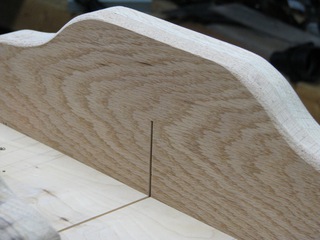 Built a crosscut sled, years ago, for Dad's tablesaw. A crosscut sled is a platform that rides on rails in the miter-slots. Because it rides in both miter-slots, it's more stable than a miter gauge. Because the rear fence is fixed at 90° to the blade and, unlike a miter gauge, it doesn't swivel, crosscuts are reliably at right-angles. The fence provides a clamping surface for things like stop blocks, tenoning jigs, miter-blocks, etc. And the fence means less splintering of cut wood. The fence replaces the sacrificial piece of scrap.
Built a crosscut sled, years ago, for Dad's tablesaw. A crosscut sled is a platform that rides on rails in the miter-slots. Because it rides in both miter-slots, it's more stable than a miter gauge. Because the rear fence is fixed at 90° to the blade and, unlike a miter gauge, it doesn't swivel, crosscuts are reliably at right-angles. The fence provides a clamping surface for things like stop blocks, tenoning jigs, miter-blocks, etc. And the fence means less splintering of cut wood. The fence replaces the sacrificial piece of scrap.
The sled must be custom-built to each tablesaw. So, when I built one for Dad, I was working in his shop with his tools. Like his bandsaw and belt-sander. That made cutting and shaping the fences pretty easy. I don't have either of those tools. So I laid-out the curves using a draftsman's French Curve. I cut them with my $20 Black & Decker scratch-and-dent outlet-store jigsaw. Then I eased the edges with a four-in-hand.
The runners are UHMW plastic. The platform is ½" birch plywood. The fences are 1½"-thick red oak. The platform is under-sized for the saw. When I started work on the sled, I sized it for the saw I inherited from Nicole's Dad. My current saw is larger. I screwed the fences to the platform, without glue, so that I can use them with a larger platform, later. At the moment, the largest Item I can cut is 8" across. It's already proven useful, though.

